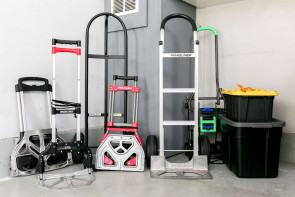
The Best Leaf Blowers
After two months of testing battery-powered, plug-in as well as two-stroke gas blowers on a ten-acre orchard, we found the Toro – 51621 proved itself the best leaf blower. We picked the plug-in Toro for its great balance of impressive power that comes in a quiet and maneuverable package. If you’re working with a big driveway or a shortage of outlets, we also liked the convenience of the cordless Dewalt – DCBL720P1.
After two months of testing battery-powered, plug-in as well as two-stroke gas blowers on a ten-acre orchard, we found the Toro – 51621 proved itself the best leaf blower. We picked the plug-in Toro for its great balance of impressive power that comes in a quiet and maneuverable package. If you’re working with a big driveway or a shortage of outlets, we also liked the convenience of the cordless Dewalt – DCBL720P1.
Table of contents
- How we selected finalists to test
- Compare the best leaf blowers
- Blower types
- Do you need a vacuum for mulching?
- Important features to consider
- How we tested
- Best electric blower: Toro – 51621
- Best cordless blower: Dewalt – DCBL720P1
- Other finalists we tested
- The bottom line
How we selected finalists to test
We looked at top-rated blowers from publications like Consumer Reports, Popular Mechanics and GardeningProductsReview.com. We looked primarily at brands that are well-reviewed and easy to find and purchase. (Sorry, Stihl; a one-brand authorized dealer network might be a good place to buy tools for a landscaping company, but we like our internet comparison shopping.)
This lineup includes blowers with customer reviews that indicate more than just satisfactory performance and models regarded as quiet and efficient. We picked two models with vacuum and bagging options, both well-regarded for their capabilities there.
Gasoline-powered blowers have taken a real beating in the press this year, especially after a number of towns in New York and New Jersey decided to ban them during the summer months when they’re mostly used to clean up grass clippings, not to collect leaves. There is even a lobby organization dedicated to eliminating gas-powered landscaping tools, especially blowers.
Hand-held gas blowers didn’t make this review since, aside from those noise and pollution complaints, they’re both expensive and require more maintenance than many homeowners will want to deal with.
We did include a bigger backpack-style gas-powered blower to see what the extra power can do (and how much noise it really makes), and we also had a giant 9 HP walk-behind blower on hand for comparison.
Compare the best leaf blowers

| Product | Price | Weight (lb) | Type | Power Score (out of 5) | Vacuum Function |
|---|---|---|---|---|---|
| 1. Toro - 51621 | $$ | 8.2 | Electric, Corded | 3.7 | Yes |
| 2. Dewalt - DCBL720P1 | $$$$ | 7.4 | Electric, Cordless | 1.9 | No |
| 3. Echo - PB-580T | $$$$$$ | 23.4 | Gas, Backpack | 5.0 | No |
| 4. Worx - TriVac WG509 | $$ | 9.4 | Electric, Corded | 2.2 | Yes |
| 5. Greenworks - 24012 | $ | 4.6 | Electric, Corded | 2.1 | No |
Blower types
Plug-in electric
Most of the blowers we tested fall into this category. A cord does limit the distance you can move around your yard, but there’s a huge advantage: all the power you’re using is stored in the grid, so you don’t need to carry around a fuel tank or a heavy battery.
Plug-in blowers are very good at providing just the right amount of power for backyard leaf-blowing, and many also give you the option of vacuuming and mulching leaves for bagging or composting. (There are gas-powered leaf vacuums, but they’re becoming less and less common.)
This style is a compromise between clean, quiet operation and available power. If we had to pick just one blower for an urban backyard, it would definitely be plug-in.
Cordless, battery-powered electric
Battery-powered tools have been evolving steadily since Black & Decker created the first battery-powered drill using Nickel-Cadmium cells back in 1961. We’re now seeing widespread use of Lithium Ion cells, very similar to the battery in your laptop or cell phone, which don’t have nearly as many problems as older battery types.
Battery power is very convenient for short bursts of moderate power, like daily sweeping on a small yard and a driveway. If you need to work for longer than 20 minutes, though, the long charge time makes this a poor choice. You can buy additional battery packs to work longer, but the cost of a battery is a significant part of the tool’s price.
Gasoline
If being tethered to an electrical outlet just isn’t an option, gasoline-powered blowers are another way to go.
Professional landscapers use gas-powered blowers not only for freedom of movement, but also because gas motors put out far more power than a compact battery is capable of. We tested the Echo – PB-580T: a backpack-style blower with almost four times more working power than DeWalt’s 20V battery model.
The downsides to a two-stroke gas engine are also readily apparent. You need to mix special oil into the gasoline (or buy pre-mixed fuel), and the difference in noise levels is huge.
We measured 95 dBA of sound pressure at the distance of an operator’s ear, which means you should use ear plugs if you’re working with a blower like this for more tham an hour per day. It’s slightly less than a typical gas-powered chainsaw or string trimmer, though.
That said, It’s easy to see why gas-powered tools are still popular among professionals. If you keep fuel on hand in a small gas can, you can run your blower for six hours. We didn’t test a hand-held gas blower because the electric models were so highly rated, but gasoline still has a place on a property with lots of ground to cover.
Walk-behind blowers

This is a special category of leaf blower for people who need to clear a large area of pavement or concrete quickly. They’re mounted on wheels because they weigh about 150 pounds, but the amount of power on tap is pretty impressive.
Our test partners at the orchard use an older model of the Little Wonder Optimax blower for clearing driveways. With a 270 CC Honda engine attached directly to a giant fan, it’s rated to push 2260 cfm of air — more than five times what our top electric blower puts out.
That means you can clear a long driveway as quickly as you can push the blower, but it won’t do much for a big lawn with the on-road-only wheels. It also has a nasty habit of peeling up loose sod and destroying flower beds if you’re not careful where you point it. For clearing the driveway it works very well, unless you have a steep slope: these beasts are much easier to roll down a hill than they are to push back up.
Do you need a vacuum for mulching?
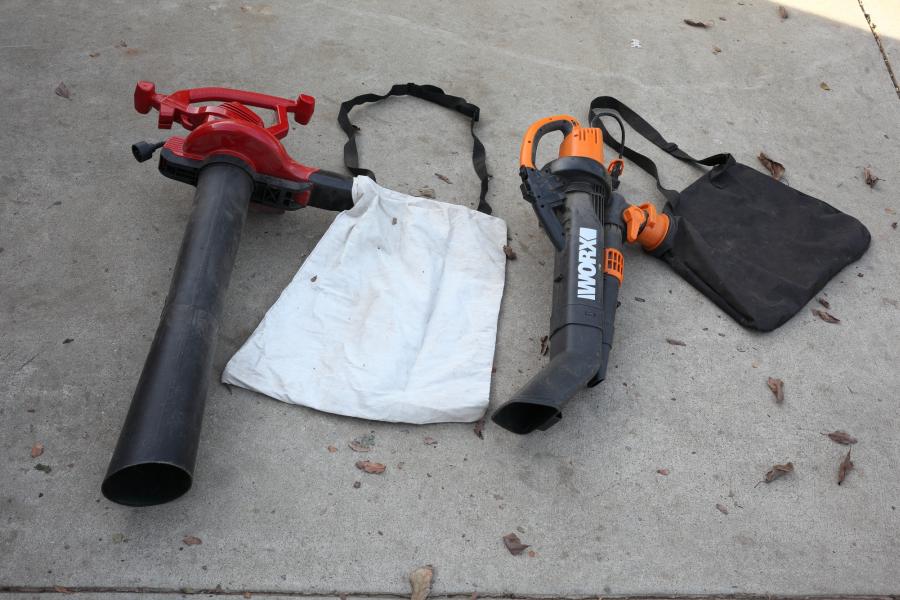
There’s a bit of controversy surrounding leaves, mulching and bagging.
Leaves and grass clippings are organic material that grows from your lawn, so there’s no question that removing them is also removing nitrogen and other plant nutrients from your lawn’s natural life-cycle.
What’s more, curbside pickup of bagged leaves might not even be available in your area. Leaves have to be composted, rather than going to a landfill, and it takes even more energy to transport all the leaves to a city composting site than it does for you to bag them.
That said, if you’ve got trees dropping all their leaves on your lot in October, you’ve got to do something with them (and blowing them into the street doesn’t count). If you just let the leaves accumulate, they’ll block the sunlight that your grass needs to store energy for winter — or worse, the leaves can get soggy and musty.
Many experts advocate mulching organic material back into your lawn with a mower that chops up leaves and spreads them as it cuts. (This is often called a “mulching mower,” but some people use that term to refer to a mower that collects mulch in a bag.)
Research like this study from Michigan State University definitely shows that mulching leaves back into the turf is good for your lawn. A lawn mower like our top pick from Honda will shred the leaves small enough that they filter down into your turf and nearly disappear.
Some homeowners strive to achieve the pristine green that you can only get by collecting leaves and clippings, and a blower with vacuum options is one tool that can help. Consumer Reports has published this guide that discusses strategies for using a leaf vacuum.
We definitely appreciated having the vacuum options on two of the blowers we tested, but we found them most useful for selective work. Collecting leaves around a pool or fountain, for example, is much easier when you can suck up the leaves instead of accidentally blowing them into the water.
Mulching leaves is a valuable part of lawn management, but we can’t say that there’s a leaf vacuum on the market that will make bagging an entire lawn worth of leaves easy.
Important features to consider
Cubic feet per minute is a measurement of overall volume of air the blower can move and should always be a relatively accurate measurement of overall power.
Miles per hour, on the other hand, is a measurement of the speed of the air that’s coming out of a blower. The speed will change, though, depending on how much room the air has to move: a small opening will yield higher speeds with more blasting power, while a wide nozzle might be much better at moving a wide swath.
There’s no definitive standard for where or how to measure airspeed, so we’ve done actual testing with weighted test objects and common tasks to give you an idea of how the blowers put their power to work.
Amps is a measurement of the amount of electricity that travels through a circuit each second. Corded electric tools will always tell you how many amps they pull, since you need to know that number in order to choose a big enough cord and avoid blowing your 15A circuit breakers.
Cordless tools, on the other hand, will rarely advertise how much energy they’re actually consuming, nearly always emphasizing the voltage and capacity (amp-hours or watt-hours) of the battery instead.
Watts measure the total amount of energy used, and we can even include a rating for gasoline engines. These numbers are provided by the manufacturers, and they’re only measuring the amount of energy that’s used up rather than the amount of actual work done, but it’s a handy reference for the size and power of a machine.
Mulch Ratio is how much space you’ll save if you mulch your leaves instead of raking them into a bag whole. Consumer Reports has found that the manufacturers’ listed ratios are exaggerated by four or five times, though, so we don’t put much stock in these numbers when picking machines. Toro lists “97% reduction to half-inch pieces,” while Worx claims an 18:1 reduction.
How we tested
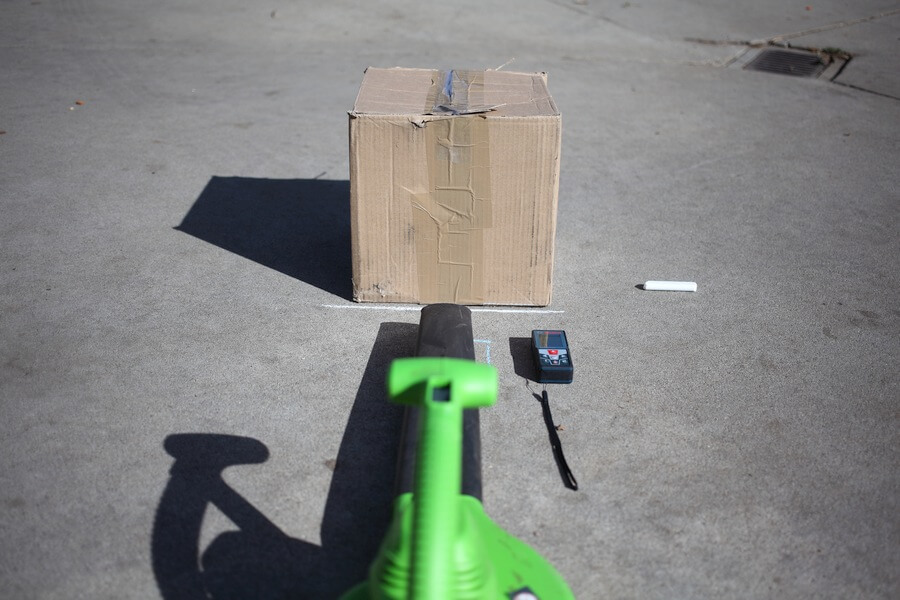
Test 1: Force
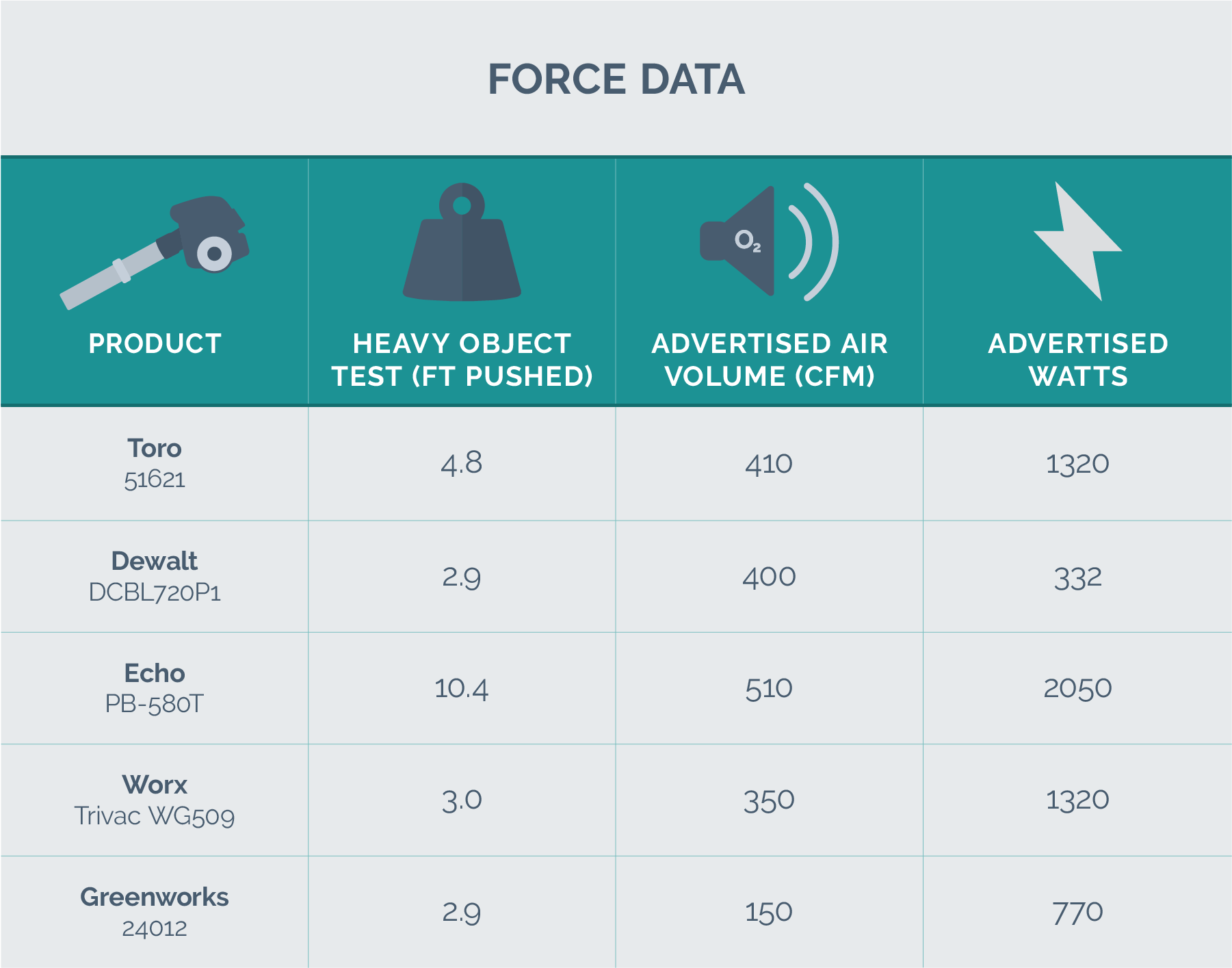
If you need to move debris and gravel or to lift damp leaves out of your grass, then this is the chart that’s going to be most important.
We used a small weighted box to see how much brute force each blower has when you give it a big surface to blow against. The chart lists the distance our two-pound weight was pushed beside the manufacturer’s rating for total blower output in cubic feet per minute.
Test 2: Air speed
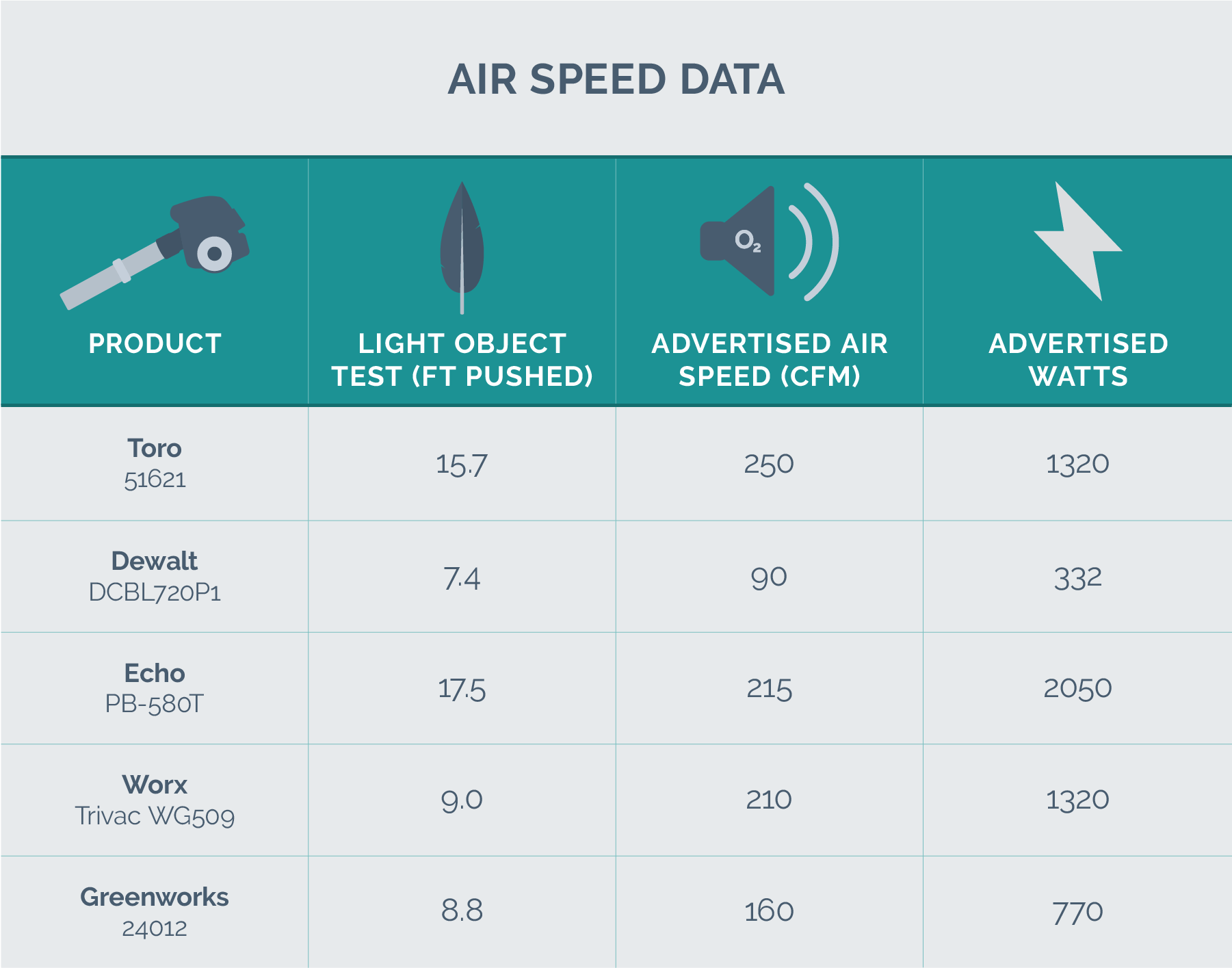
If you’re primarily blowing loose leaves to clear a big area, then this is most important chart to look at.
We measured how far each blower could throw a plastic pouch full of leaves with a quick-moving airstream. The chart includes the manufacturer’s assessment of air speed in miles-per-hour. The test object weighed four ounces, and the results line up with performance we observed sweeping leaves in our field tests.
For example, we see that the outlet tip on the Toro blower makes the air go faster than the giant tube on Echo’s blower, so the Toro was able to keep up when blowing leaves around even though it doesn’t move as much air overall.
The Worx blower, on the other hand, is only slightly better than the tiny Greenworks blower despite the narrow nozzle. It just doesn’t move enough air to be effective at clearing large areas.
Test 3: Noise levels
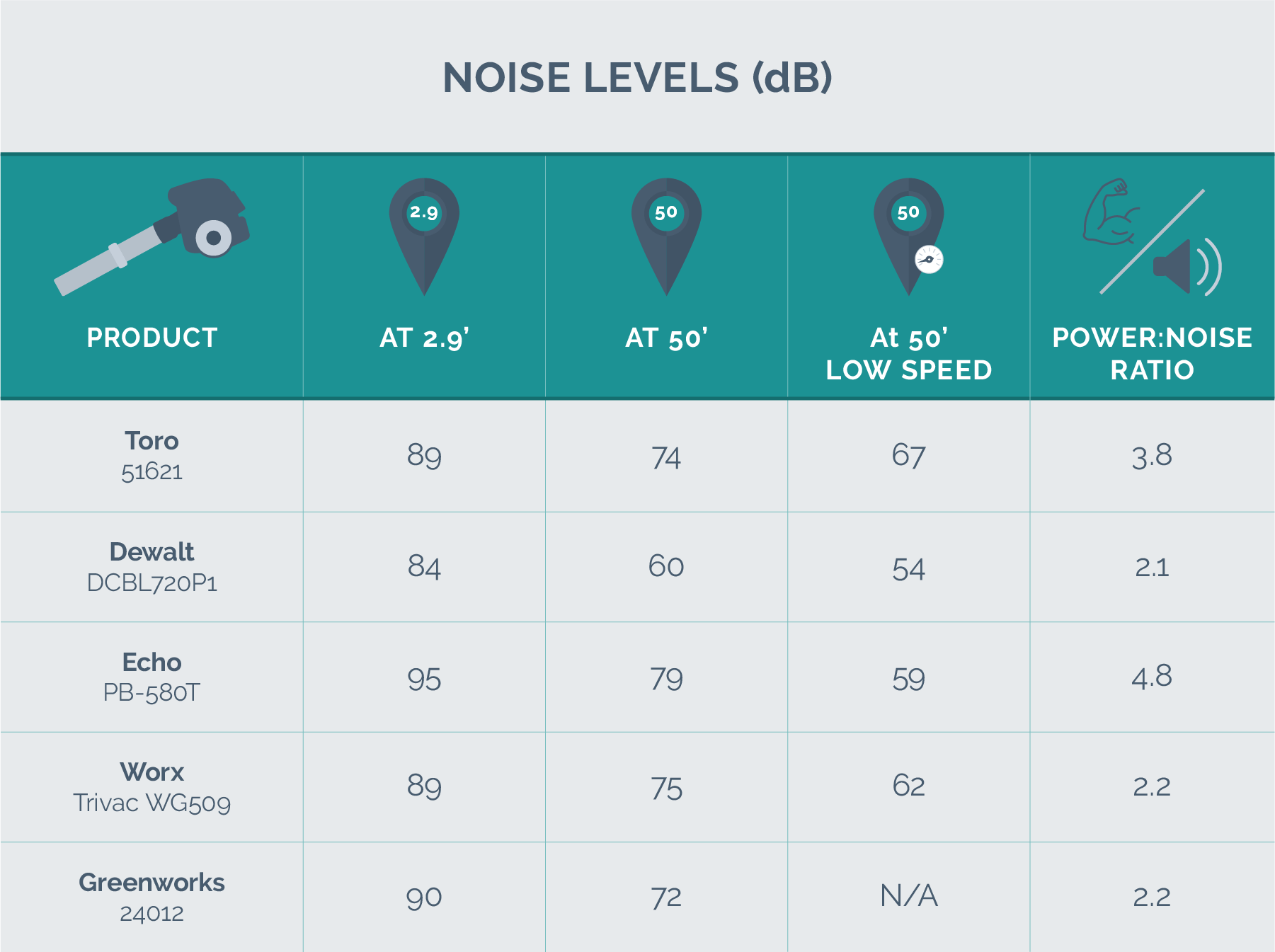
We measured the noise levels of each blower with our calibrated sound pressure level meter setup in three positions: at ear height, from 50 feet away and from 50 feet with the variable-speed control (if the blower has one) turned all the way down. Measurements are A-weighted (as most industry regulations require) and averaged over 30 seconds using Room EQ Wizard to ensure consistency.
For reference, some ordinances prohibit sound levels as low as 50 dBA before 7 AM in residential communities. 65 dBA at 50 feet is a common daytime maximum, so be careful using any blower around sensitive neighbours. More and more towns are beginning to ban loud leaf blowers, even electric blowers, so find out about local ordinances. Nonoise.org has a good collection of information from many American cities if you can’t find info on a local county or city website.
What about safety for you, the owner of the blower? Unless you’re blowing for more than a few hours every day, only the gas-powered blower is loud enough reach noise exposure levels that cause damage. Even the backpack blower isn’t as loud as a chainsaw or a weed wacker, but if you’re using any blower for a full day at work you should definitely be wearing hearing protection such as ear plugs.
Regarding safety, note that because sound pressure is measured on a logarithmic scale, every 3dB change represents a doubling in sound intensity. So, in terms of the health of your ears, a 6dB difference is four times more sound.
We tested an additional data point: if you just need to blow a few leaves off your walk early on a Saturday morning, most of these blowers do offer a speed control that will let you turn down the noise. The DeWalt cordless blower was really the only one that was quiet enough to consider using in a noise-sensitive situation, and it’s still not below the 50dB threshold that’s often used before 7 AM.
The way your neighbours perceive the sound of your lawn tools is not the same as measured results, of course. The decibel scale represents power in a logarithmic slope, but our brains respond in an even less linear way to changes in sound, and your family might not even notice a difference of 3dB, even if it is a lot more power. Your neighbor’s sleeping baby or dog will probably not care if you’re below a legally allowable noise level, but it’s good to know where you stand.
Test 4: Power comparisons

Compared to the capacity and voltage comparisons between battery-powered tools, comparisons of plug-in appliances might seem pretty boring. Bigger is better, right? There’s a catch, though, to drawing all that current from the wall plug: you need to be careful about using a big enough cable to get power to your tool.
The official National Electrical Code listing for cable conductor sizes involves some complex math and is more concerned with wiring inside your walls than lawn tools, so we rely on interpretations in the guide published by Home Depot.
16-gauge cords are common and will work well for our big plug-in blowers at 50 feet, but that’s not the end of the story. Wire heats up when you run electricity through it, and the longer the cable is, the more it will heat up.
If you need to buy a 100’ cord or tie two 50’ cords together, you should go up in size to 14-gauge wire. (Smaller number, bigger wire.) A 14-gauge extension cord is not as easy to find or inexpensive as a 16-gauge cord, but it’s well worth the cost when you consider what might happen if you melt a cord running too much current through it.
For battery and gas-powered blowers, we’ve provided the average running times we achieved after a season of leaf-blowing. Refilling a gas tank is quick compared to waiting on a battery charger, but don’t forget to keep some gas and two-cycle oil on hand in a gas can, or it could take you significantly longer to go re-supply at a gas station or hardware store.
The best electric leaf blower: Toro – 51621

Toro’s top-selling blower, the plug-in model 51621, comes with a kit that includes mulching and bagging accessories as well as a variety of different air-shaping nozzles. This is a versatile kit, but we picked it primarily for its raw power output.
In testing, we found that this blower could move bigger debris and throw leaves much farther than most of the other blowers, and it was better at loosening leaves out of long grass. In our distance test, el Toro threw our weighted test objects almost as far as the big backpack blower did.
The added accessories do make a difference, though. Being able to switch to vacuum-mode means you can do jobs that simple blowers can’t. The included oscillating tip makes it a little bit more efficient for sweeping off wide areas of concrete, though we didn’t notice much change when we were working on grass.
Toro’s blower isn’t perfect. To use it as a vacuum, you can exchange the blower tube for a bag, and the guard over the intake fan for a vacuum tube. The fit of the guard is snug, and changing the accessories could have been a little bit easier. That said, the recall on a close competitor, the Black+Decker’s BV5600, was over a very similar guard that was so loose it would fall off. We’ll take a bit of prying over lacerated fingers any day of the week.

Black+Decker’s BV5600 got a good review from The Wirecutter and Popular Mechanics and goes together as a kit in a similar way. Beyond the safety recall, Consumer Reports gave it a much lower score because it lacked power, so we stuck with the Toro.
If you’re planning to use this blower for long periods of time on the lowest power setting, the big speed controller does have a tricky habit of bumping to “off” if you jiggle it or even if you shake the blower.
It’s easy to ramp the speed up and down if you have a free hand, but it’s not like the trigger-control on the DeWalt cordless blower that lets you flick precise blasts of air. The speed control works if you need to turn things down for careful work around flower beds, but low-speed work is not its strong suit.
The cord lock integrated into Toro’s handle is not the best we’ve used, but we figured it out without needing to look it up in the manual and we never had a cord come unplugged.
With a 50-foot extension cord most people should have no trouble cleaning their lawns and patios with this plug-in blower, but if you need more length be sure to get 14-gauge extension cords: this blower draws 12 Amps, and that means typical 16 gauge cords will start getting too hot if you daisy-chain them out to 100 feet.
Another feature that solidified the Toro’s spot in first place is a blue hook that slips over the blower tube and gives you a way to wrap your extension cord neatly around the blower for storage. We prefer to hang our cords on a hook in the garage, but Toro is providing real options that the other manufacturers just don’t seem interested in.
Key takeaways:
- The Toro – 51621 blower/vacuum has far more power than the other blowers in its class, but it manages to be a little bit quieter than the other plug-in models, too.
- Plug-in power means you need a cord long enough to reach wherever you’re blowing, but you’ll never have to worry about batteries or fuel.
- Toro includes extra nozzles for specialized work and a well-designed vacuum function, making this a complete package.
- No cord included: if you need more than 50 feet of reach make sure to get a heavy-duty 14-gauge cord.
Best cordless leaf blower: Dewalt – DCBL720P1
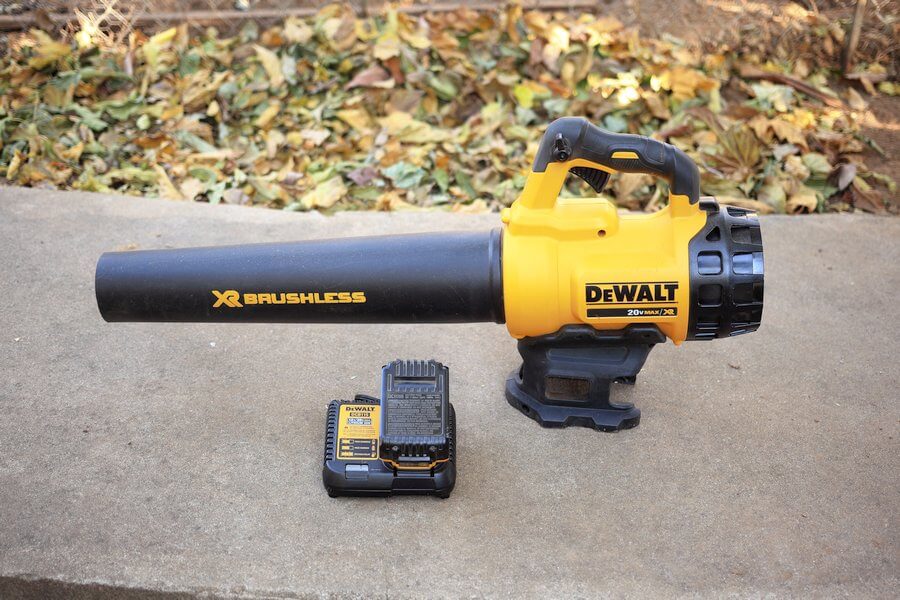
A 20V lithium-ion battery can’t deliver as much power as a gas engine or a 120V extension cord, but the Dewalt – DCBL720P1 earned our respect with usable power and the freedom of lightweight cordless use.
If you’re lifting leaves that have been sitting on a lawn for a week and settling into the grass, the amount of power this blower offers might be disappointing, and the Toro blower can run circles around it doing tough jobs.
If you just want a blower for sweeping leaves off your sidewalk and into a pile, though, the cordless design means you can move quickly. If you’re concentrating on one spot a cord isn’t a big hindrance, but this blower excels at roaming up and down long driveways just as well as clearing hard-to-reach gutters or the corners behind your trash cans.
Effectively, this blower makes up for a lack of reach by making it easier to get close to the leaves you’re blowing. That also means it’s a bit easier to be careful about not blowing leaves across property lines or damaging flower beds, but it also means you’ll spend more time walking.
The lower output also means this is also a very quiet blower, and the variable-speed trigger is by far the easiest to use of the bunch. (There’s also a locking thumb-lever that keeps the speed where you want it if you’re doing a bigger job.) It’s still as loud as a vacuum cleaner, so you’re not going to be some kind of lawn ninja who clears leaves unnoticed, but it’s a nice perk.
For spending an entire morning collecting leaves off your yard, this wouldn’t be our first choice, but it’s very convenient not having to worry about cords or gas cans when the leaves start falling and you just want to clear off your deck.
At the end of the day this didn’t make our top pick because an 18-minute runtime is just not going to be enough for some jobs, and stopping in the middle of a job to wait more than an hour for charging is just a pain. This is a worst-case runtime, though, with the trigger locked on full and no breaks. If you take full advantage of the smooth and easy trigger control you should be able to get five or ten more minutes out of a battery, but it’s difficult to translate that to real-world time walking around your yard without defining exactly how much force you need to push your leaves and how far you need to push them.
If you’ve already got one or two of DeWalt’s 20V Max batteries (or one of the new batteries for the Flex-Volt 20V/60V system) then the run-time limits might be less of a problem, but this still isn’t a tool for big jobs.
At the end of our testing period, we have mixed feelings about this blower. The price is especially hard to swallow, basically double what you pay for a good plug-in blower like our top pick. But this blower can go anywhere without worrying about cords, and it doesn’t have the inconvenience and weight of a gas-powered blower. This might make it sound like a niche tool, but we found ourselves reaching for the DeWalt first when doing frequent, easy jobs like blowing off walkways after mowing.
As is the case with most cordless tools, this blower is very handy and great to have around, and you might be surprised at how little you notice the power difference compared to the ease of working without a cord. (Just don’t forget to charge the battery when you’re done.)
Key takeaways:
- The Dewalt – DCBL720P1 isn’t the perfect tool for every job, but it has just the right amount of power for most leaf-blowing.
- The battery isn’t going to astound you with its capacity, but there’s enough working time for weekly yard chores.
- Remembering to charge the battery is a bit of a pain, but it’s still faster and easier to drop the battery in a charger after each use than to untangle a heavy extension cord or remember to fill a gas can.
Other finalists we tested
Echo – PB-580T
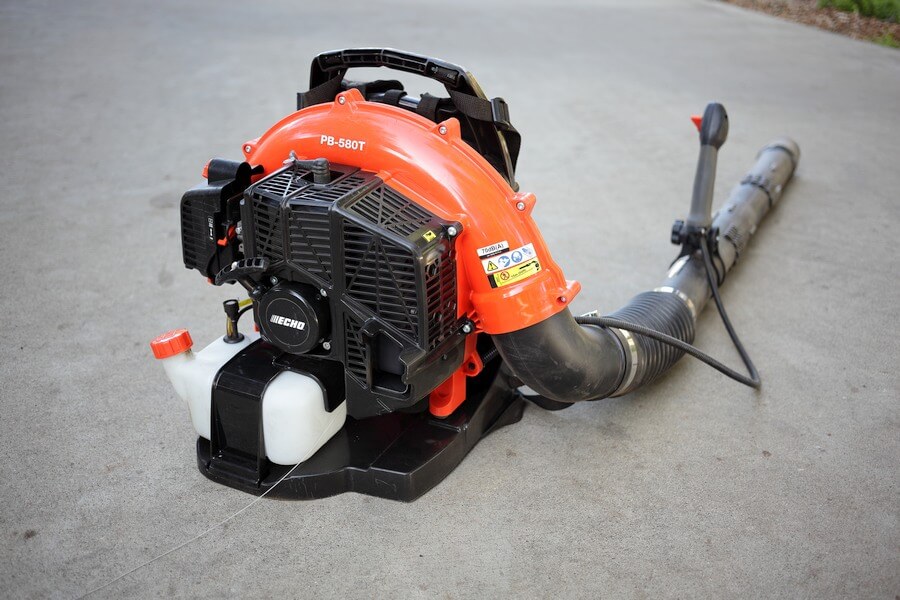
The PB-580T from Echo is a representative pick: this was a well-reviewed and economical choice from a wide field of two-cycle gas blowers. This is the kind of tool you’ll know well if you’re working professionally around yards and parks, but some homeowners with property backing onto parkland might consider it too.
The downsides, naturally, are many. Starting never took more than a few pulls if we followed the prime/choke/throttle/pull procedure carefully, but that’s still a lot of steps compared to the power-and-go simplicity of electric blowers. The run time was good and refuelling was pretty easy, but those are still factors you don’t have to worry about with our top pick.
Gas-powered blowers are also becoming increasingly less popular with neighbours and city councils, so think carefully about who might be affected by your leaf-blower choices.
Pre-mixed gas like TruFuel is a handy way to keep fuel on hand for occasional use, but it’s not cheap. The brand-name oil additive with handy measuring bottle makes it easy to add when you’re filling a gas can, and if you’re refilling that a few times per season it definitely pays off.
The noise that this machine makes is unmistakable. It rumbles, buzzes and chatters at idle like most two-stroke engines do, but it actually put out less noise energy (however distinctive it might be) when idling than the big electric blowers did at their lowest speeds.
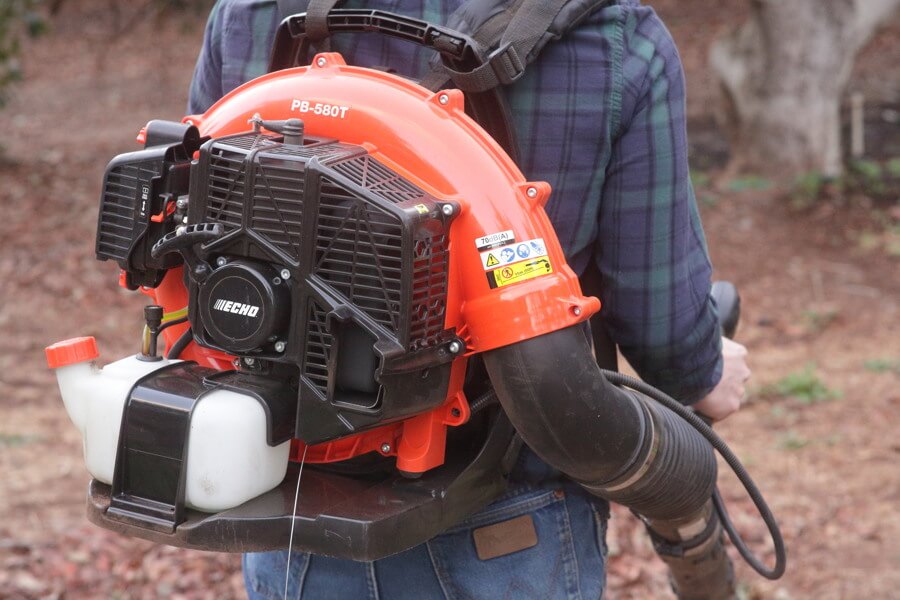
Of course when you pull the trigger to spin the fan up this is a loud machine. You’d be wise to wear hearing protection like ear plugs when you’re doing big jobs, but it doesn’t put out the ear-splitting volume of something like a chainsaw.
There are other options if you have a yard too big for a cord: handheld gas blowers like the Hitachi – RB24EAP costs less than a backpack blower, but they don’t put out significantly more air than our electric top pick. There are also bigger lithium-ion cordless systems, like the 56V Power+ from Ego (out of stock when we purchased our testing group) that put out an impressive amount of air, but can’t run longer than about 20 minutes on a battery.
The backpack blower is a tool that makes no compromises: it goes where corded blowers and even the big walk-behind gas blowers just can’t go, but it can keep going for as long as you can keep topping off the fuel tank. It’s not a vacuum or mulcher, and it’s not lightweight or quiet, but if you need to clean a ¼-mile-uphill driveway it’s practically perfect.
Worx – Trivac WG509
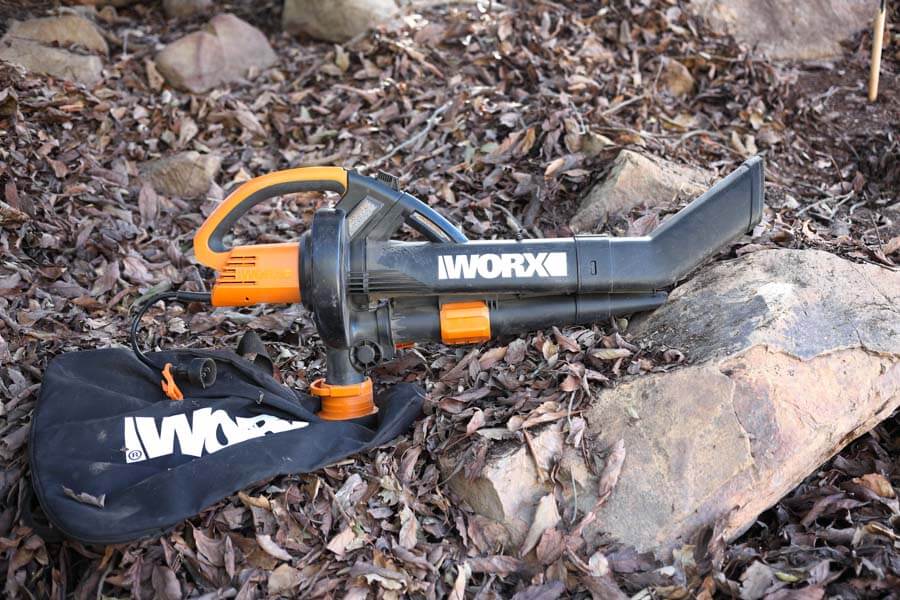
There are things to like about the TriVac WG509 from Worx, but on the whole it’s just not competitive.
The only reason we might recommend this blower over the Toro is if you need to switch quickly and frequently between blowing and vacuuming leaves: Worx made this blower so you can leave the bag attached all the time, and switch the output between the bag and the blower tube with a simple flip of a lever.
As a blower, though, it’s just not great. The outlet nozzle is small and hides underneath the large vacuum tube, which makes it tricky to maneuver in tight spaces. It has more power than the cordless DeWalt blower or the little GreenWorks blower, but compared with the Toro it’s very underwhelming.
As a vacuum the shape and handle are well-designed, but for blowing we found the Toro’s pommel-grip handles made it easier to sweep and pile direct leaves. The Worx blower is a pound heavier, too, even without the bag attached.
For nearly the same price, the Toro electric blower is much more powerful, more versatile, and easier to use.
Greenworks – 24012

Greenworks makes a lot of inexpensive lawn tools, and the 24012 is pretty much what you’d expect. The best thing about it is definitely the price, but it deserves the high 4.5-star overall rating on Amazon since it does what it can within a budget.
In testing, this blower doesn’t move very much air. There’s enough to move leaves around, more than the cordless DeWalt and almost as much as the big Worx multi-function machine, but it’s not any easier to carry around or use than our top pick from Toro.
Greenworks didn’t provide any consideration for vacuuming, different blower patterns, variable speed or easy cord-wrapping. Even the on/off switch is about as basic as it could be.
The amount of noise it makes is the one thing that’s remarkable: with a small fan spinning quickly trying to move as much air as it can, this was the loudest electric blower we tested. It’s a high-pitched whine, too, definitely something your neighbours and family will notice.
We paid $30 for the Greenworks blower, and that does count for something; if you don’t already have a long extension cord, it’ll cost almost as much as this blower does. Note that the tiny motor does means it’ll safely run on a cheap 16-gauge extension cord all the way up to 100 feet.
The bottom line
Finding the very best leaf blower for your particular situation is sometimes a tricky exercise, even without factoring price or power. You can really only pick two of the following traits: Ease of use, run-time and freedom from cords.
For those whose primary concern is quickly clearing a driveway or patio, extra power might not be all that important. The 18-minute runtime of the Dewalt – DCBL720P1 isn’t its best feature, but it’s enough time to do the jobs this blower is best at.
Right now, it really is still worth the hassle of a power cord to gain the power and run-time of a blower like our top pick. The Toro – 51621 is a blower that will do everything you need a backyard blower or vacuum to do, if you have a long enough cord. If you’ve already got one of those for a plug-in lawn mower, the Toro is an easy pick, but for nearly everyone else we still think it’s a great machine and worth the hassle.
More Reviews
The 11 Best Expandable Garden Hoses
Joey's Garden Expandable Hose
Magliner - HMK119UA4
Compare-N-Save
AMES - 2519500
Black+Decker - LST136W
Honda - 21" HRR216K9VKA
Briggs and Stratton
The 12 Best Garden Hose Nozzles
SprayTec - 9-Pattern Sprayer
The Best Patio Umbrellas and Stands
Treasure Garden
The 10 Best Garden & Pruning Shears
Felco - F-2
Briggs & Stratton - 02081
The 7 Best Indoor Watering Cans
Fasmov - 1-Gallon Plastic Watering Can










